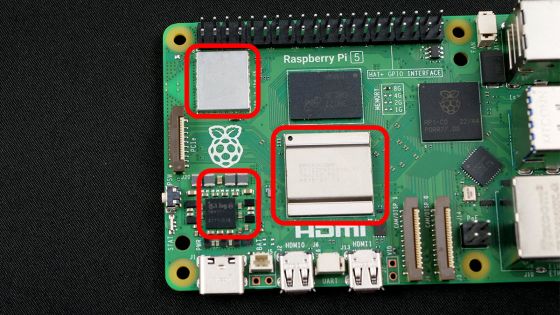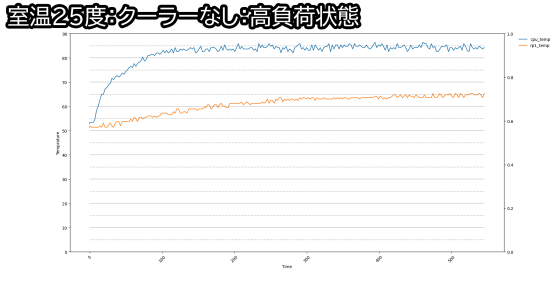Is a genuine active cooler necessary for Raspberry Pi 5? I tried to verify how the temperature changes with or without a cooler.

Shipping of '
Raspberry Pi 5 – Raspberry Pi
https://www.raspberrypi.com/products/raspberry-pi-5/
◆Preface about technical suitability
The Raspberry Pi 5 used this time was sent directly to the GIGAZINE editorial department from the Raspberry Pi Foundation and has not received technical standards compliance certification. Therefore, we have submitted a notification for the ` `special system for experiments, etc. using equipment that has not obtained technical compliance .'' In addition, in Japan, Raspberry Pi 5 is scheduled to be released after the technical compliance application by the agency, so general users do not need to worry about technical compliance.

◆Check for heat generation when the genuine cooler is installed
For Raspberry Pi 5, a genuine cooler 'Raspberry Pi Active Cooler' is provided by the Raspberry Pi Foundation. The genuine cooler can be installed without tools and can cool the SoC, power management chip, and wireless management chip. The following article provides a detailed summary of the Raspberry Pi Active Cooler's appearance, installation procedure, interference with HAT when installed, etc.

There are three thermal pads attached to the back of the genuine cooler, which can cool the wireless management chip, SoC, and power management chip.

Below is the temperature change when the Raspberry Pi 5 is equipped with a genuine cooler and left in a room with a room temperature of 25 degrees in an idle state. The blue line shows the CPU temperature, the orange line shows the RP1 (I/O management chip) temperature, and the red line shows the fan rotation speed. The CPU temperature is fluctuating between 45 degrees and 50 degrees.

Let's measure the temperature of the exterior while it is idle using infrared thermography. Since the surface of the cooler is shiny and not suitable for measuring temperature using thermography, we attached black vinyl tape to the temperature.

The surface of the cooler is 37.1 degrees.

The temperature around the power management chip was 55.4 degrees.

Next, we installed the software ``stress'' that puts a load on the system and executed the command ``stress -c 4'' to use all CPU cores at 100% and measure the temperature. When you check the system status at the time of measurement with 'htop', it looks like this.

The changes in temperature and fan speed are as follows. The CPU temperature remained around 60 degrees.

The temperature on the surface of the cooler has not increased.

The temperature around the power management chip rose to 59.6 degrees.

◆Check the heat generation when the genuine cooler is not installed
Next, remove the genuine cooler and check the temperature change.

The temperature at idle is like this. When the cooler was installed, the CPU temperature hovered between 45 degrees and 50 degrees, but when the cooler was not installed, it exceeded 60 degrees.

Next, the temperature is measured using infrared thermography. Black vinyl tape was pasted on the surface of the SoC and wireless management chip to make it easier to measure the temperature.

The surface of the SoC is 64.0 degrees.

The surface of the wireless management chip is 54.5 degrees.

The surface temperature of the power management chip was 63.4 degrees.

Next, below is a graph that records the temperature change under high load by running 'stress -c 4'. The CPU temperature exceeded 80 degrees in about 100 seconds after I started applying load, and after that it stayed around 85 degrees. According to

The temperature of the SoC surface is 85.1 degrees.

The surface of the wireless management chip is 78.1 degrees.

The surface of the power management chip was 65.9 degrees.

◆Bonus
The rotation speed of the Raspberry Pi 5's genuine active cooler is basically controlled automatically, but you can specify the rotation speed by rewriting the numbers in the file below.
[code]/sys/devices/platform/cooling_fan/hwmon/hwmon2/pwm1[/code]
For example, if you run the following command, the fan rotation speed will be approximately 8000 rpm. However, the operation may be unstable, such as ``even if you specify the rotation speed, it will automatically return to the original rotation speed'' and ``you may be able to fix the rotation speed by repeatedly hitting the rotation speed specification command'', so please do so at your own risk. Please do it.
[code]echo 250 > /sys/devices/platform/cooling_fan/hwmon/hwmon2/pwm1[/code]
◆Forum now open
GIGAZINE's official Discord server has a forum related to Raspberry Pi 5. Anyone can write from the link below, so please write something like 'I'm curious about ○○'.
• Discord | 'Raspberry Pi 5 has arrived at the GIGAZINE editorial department, so I'm going to review it, but what do you want to know? ' | GIGAZINE
https://discord.com/channels/1037961069903216680/1166304963497041981

Related Posts:






